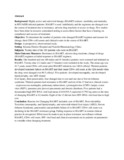Reasons for Change of Anti-Retroviral Therapy (ART) Drugs: Local Experience

View/
Date
2014Author
Otieno, C F
Otedo, A E O
Otiende, M Y
Omonge, EO
Oyoo, G O
Language
enMetadata
Show full item recordAbstract
Background: Highly active anti-retroviral therapy (HAART) reduces morbidity and mortality in HIV/AIDS infected patients. HAART is used indefinitely and the regimens are changed over the course of treatment due to resistance, adverse drug reactions or access to drugs. Few studies have been done in resource constrained setting to assess these factors that have a bearing on compliance and success of treatment.
Objective: To determine the number of patients who changed HAART regimen and reasons for change, their CD4+ cell counts and clinical events in the course of HAART.
Design: A prospective, observational study.
Setting: Kisumu District Hospital and Nairobi Rheumatology Clinic.
Subjects: Twenty nine of the 101 patients who were on HAART.
Main Outcome Measures: Resistance to HAART, adverse drug reactions, change of drugs (HAART) regimen or failed response to HAART regimen.
Results: One hundred and one (60 males and 41 females) patients were screened and initiated on HAART. Twenty nine (12 males and 17 females) were included in the study. The mean age was 41.7 years, mean CD4+ cell count prior HAART initiation was 140.8 cells/µl. Thirteen patients developed treatment failure on HAART and their mean CD4+ cell count at the 12th month when the drug were changed was 96.5 cells/µl. Five patients developed neuropathy, one developed lipodystrophy, one ART related
liver injury, three pancreatitis, four changed due to cost and one due to Steven Johnson syndrome. Thirteen patients had resistance to HAART and ten of the 13 had new clinical events: - cryptococcous meningitis, pulmonary tuberculosis, cytomegalovirus (CMV), herpes zoster virus (HZV), pneumocystis jiroveci pneumonia and chronic diarrhoea. Five patients had a documented high HIV-RNA viral load mean of 619,919.5 copies/ml (5.792 log units) at the time of changing HAART at 12 months. Eight of the 13 did not have HIV-RNA viral load due to high cost.
Conclusion: Reasons for Changing HAART included: cost of HAART, Poor tolerability Toxicities (neuropathy, and lipodystrophy, anti-retroviral related liver injury (ARLI), Steven Johnson Syndrome, pancreatitis) and probable failure of to HAART. CD4+ cell count was declining in the HAART resistance group. Failing response to HAART in routine clinical practice is recognised. Effort must be made to put in place resistance surveillance without HAART, CD4+ cell count, HIV viral load and clinical assessment are in patients on parameters to consider when changing treatment.
Publisher
University of Nairobi
Collections
- Faculty of Health Sciences (FHS) [10415]
